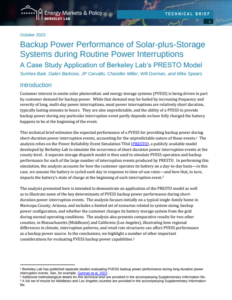Full Title: Backup Power Performance of Solar-plus-Storage Systems During Routine Power Interruptions: A Case Study Application of Berkeley Lab’s PRESTO Model
Author(s): Sunhee Baik, Galen Barbose, JP Carvallo, Chandler Miller, Will Gorman, and Mike Spears
Publisher(s): Berkeley Lab
Publication Date: October 17, 2023
Full Text: Download Resource
Description (excerpt):
Customer interest in onsite solar photovoltaic and energy storage systems (PVESS) is being driven in part by customer demand for backup power. While that demand may be fueled by increasing frequency and severity of long, multi-day power interruptions, most power interruptions are relatively short duration, typically lasting minutes to hours. They are also unpredictable, and the ability of a PVESS to provide backup power during any particular interruption event partly depends on how fully charged the battery happens to be at the beginning of the event.
This technical brief estimates the expected performance of a PVESS for providing backup power during short-duration power interruption events, accounting for the unpredictable nature of those events. The analysis relies on the Power Reliability Event Simulation TOol (PRESTO), a publicly available model developed by Berkeley Lab to simulate the occurrence of short-duration power interruption events at the county-level. A separate storage dispatch model is then used to simulate PVESS operation and backup performance for each of the large number of interruption events produced by PRESTO. In performing this simulation, the analysis accounts for how the customer operates its battery on a day-to-day basis—in this case, it is assumed the battery is cycled each day in response to time-of-use rates—and how that, in turn, impacts the battery’s state of charge at the beginning of each interruption event.
The analysis presented here is intended to demonstrate an application of the PRESTO model as well as to illustrate some of the key determinants of PVESS backup power performance during short duration power interruption events. The analysis focuses initially on a typical single-family home in Maricopa County, Arizona, and includes a limited set of scenarios related to system sizing, backup power configuration, and whether the customer charges its battery storage system from the grid during normal operating conditions. The analysis also presents comparative results for two other counties, in Massachusetts (Middlesex) and California (Los Angeles), illustrating how regional differences in climate, interruption patterns, and retail rate structures can affect PVESS performance as a backup power source. In the conclusions, we highlight a number of other important considerations for evaluating PVESS backup power capabilities.
